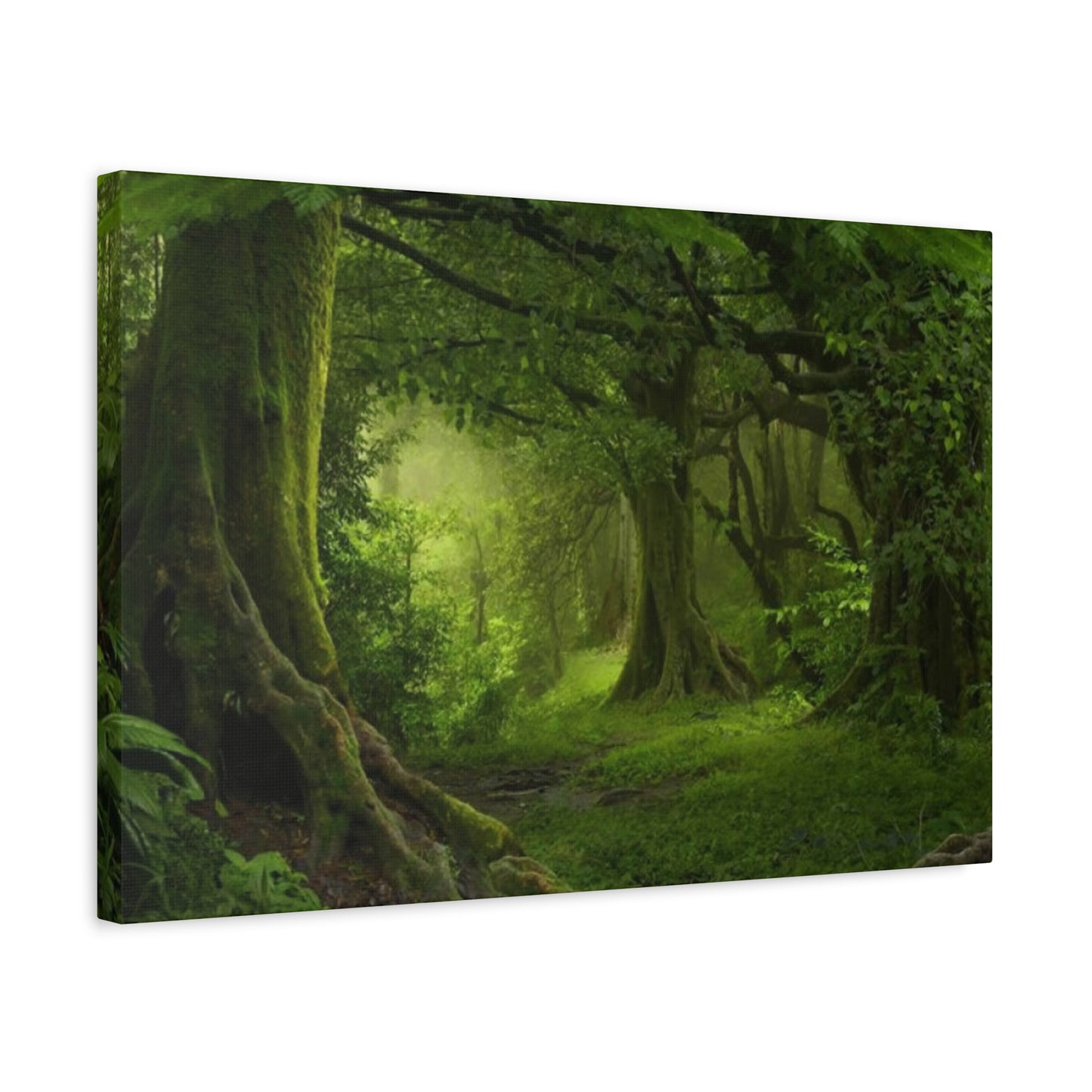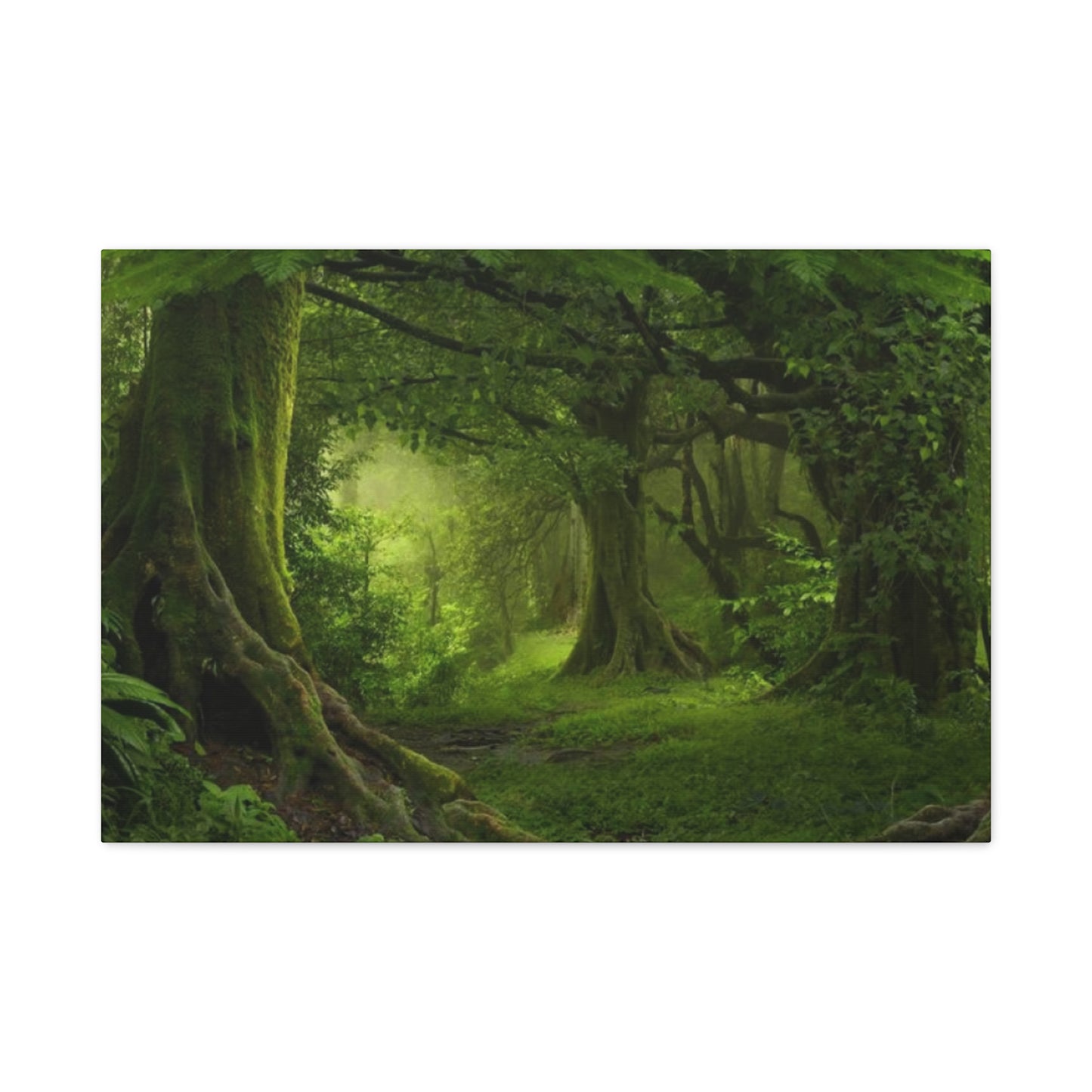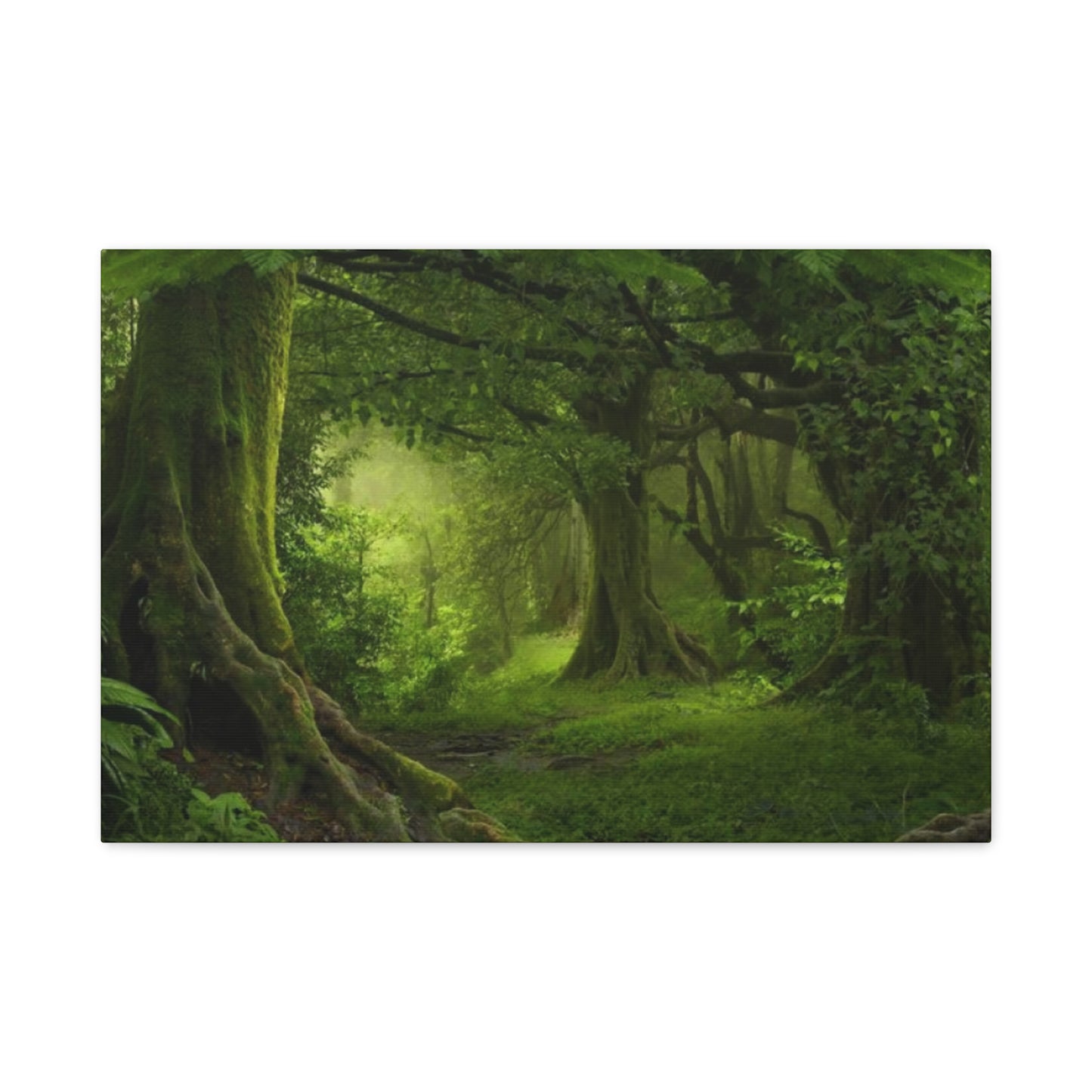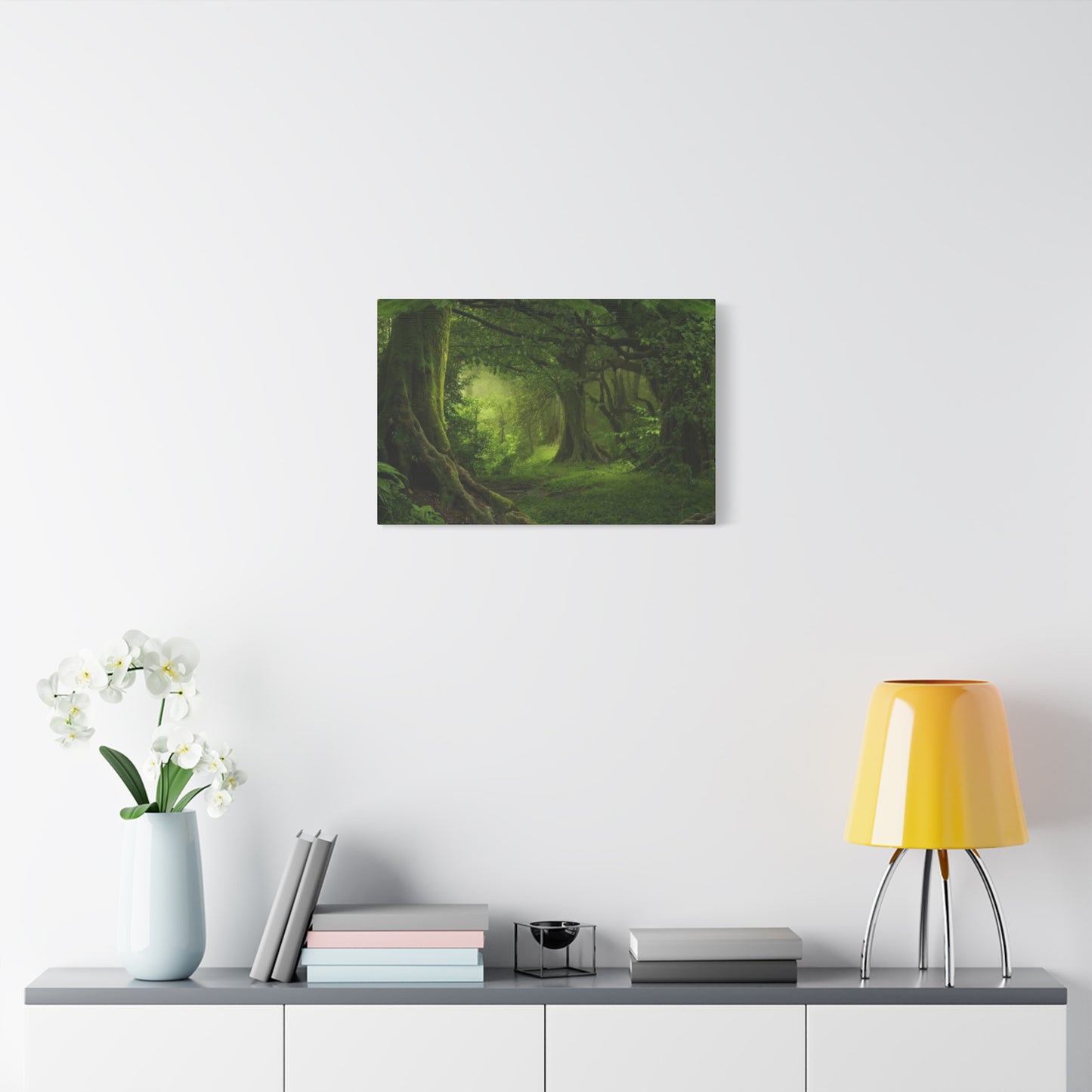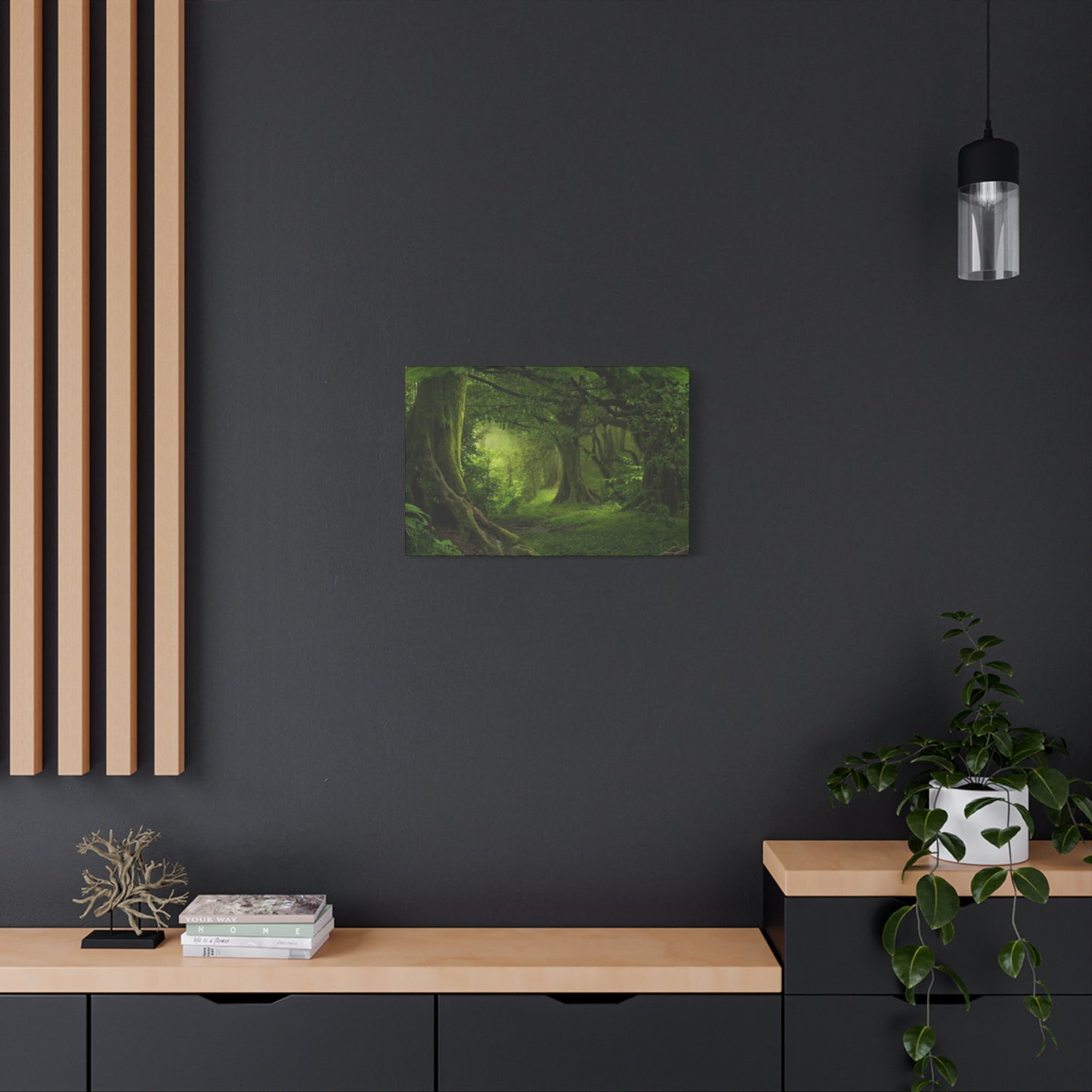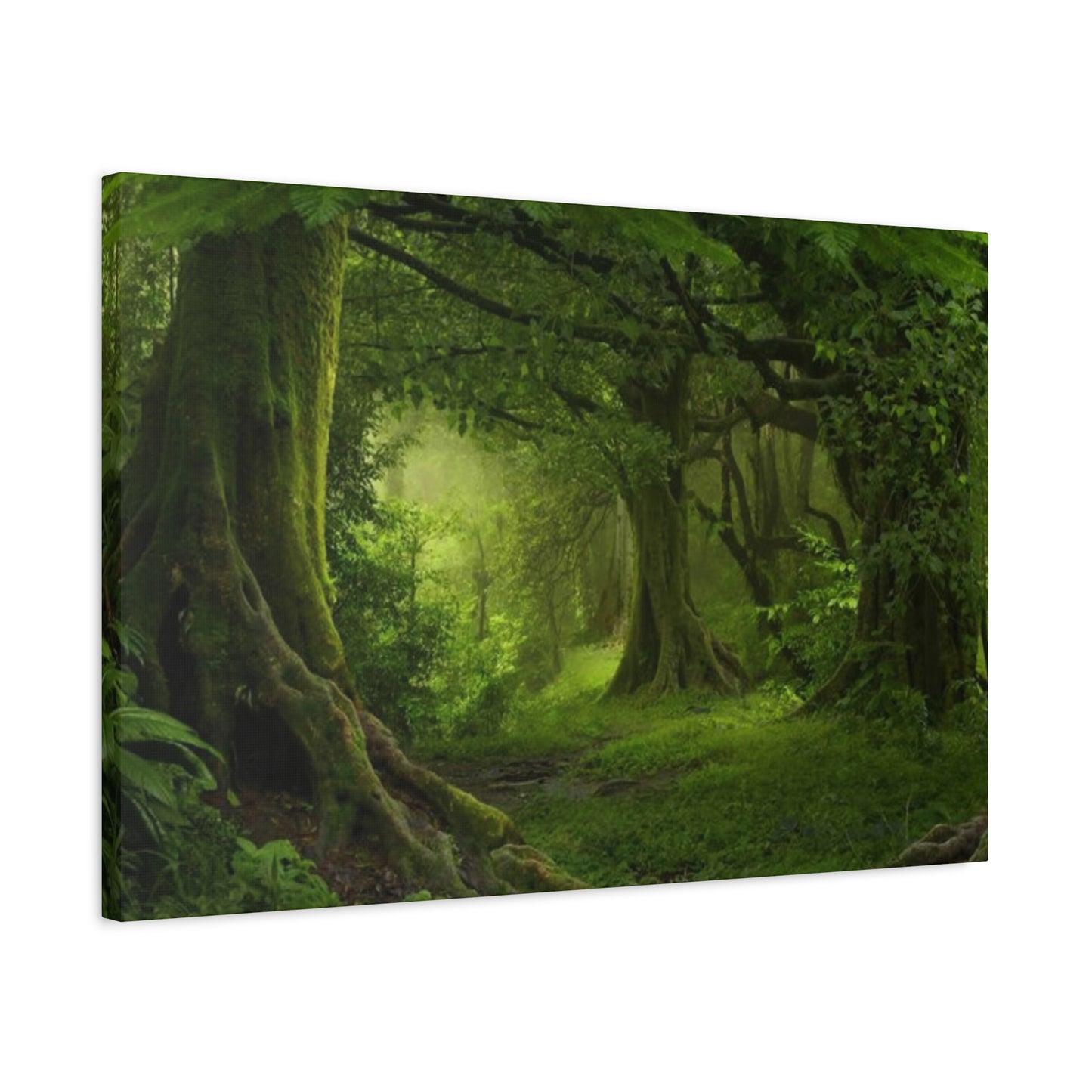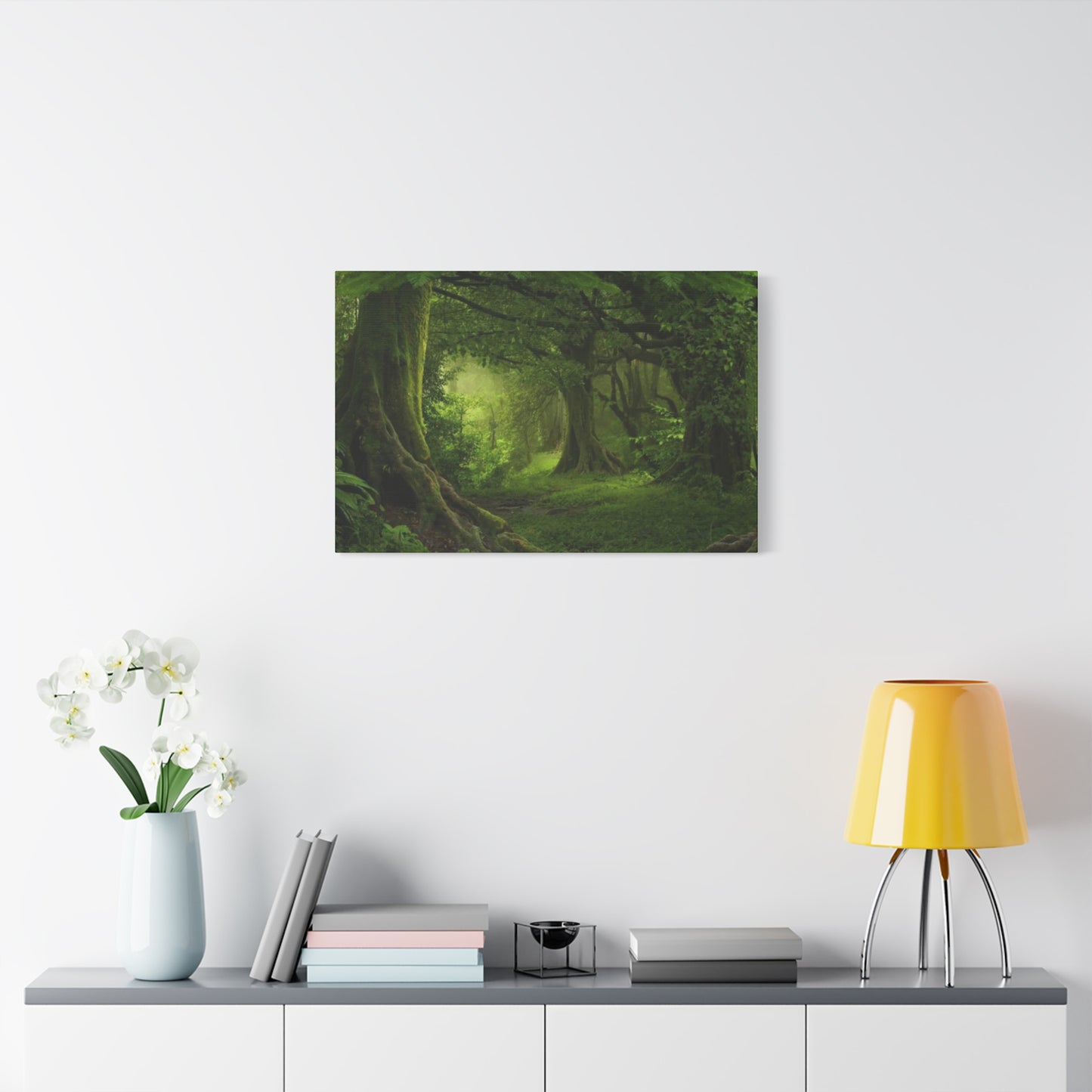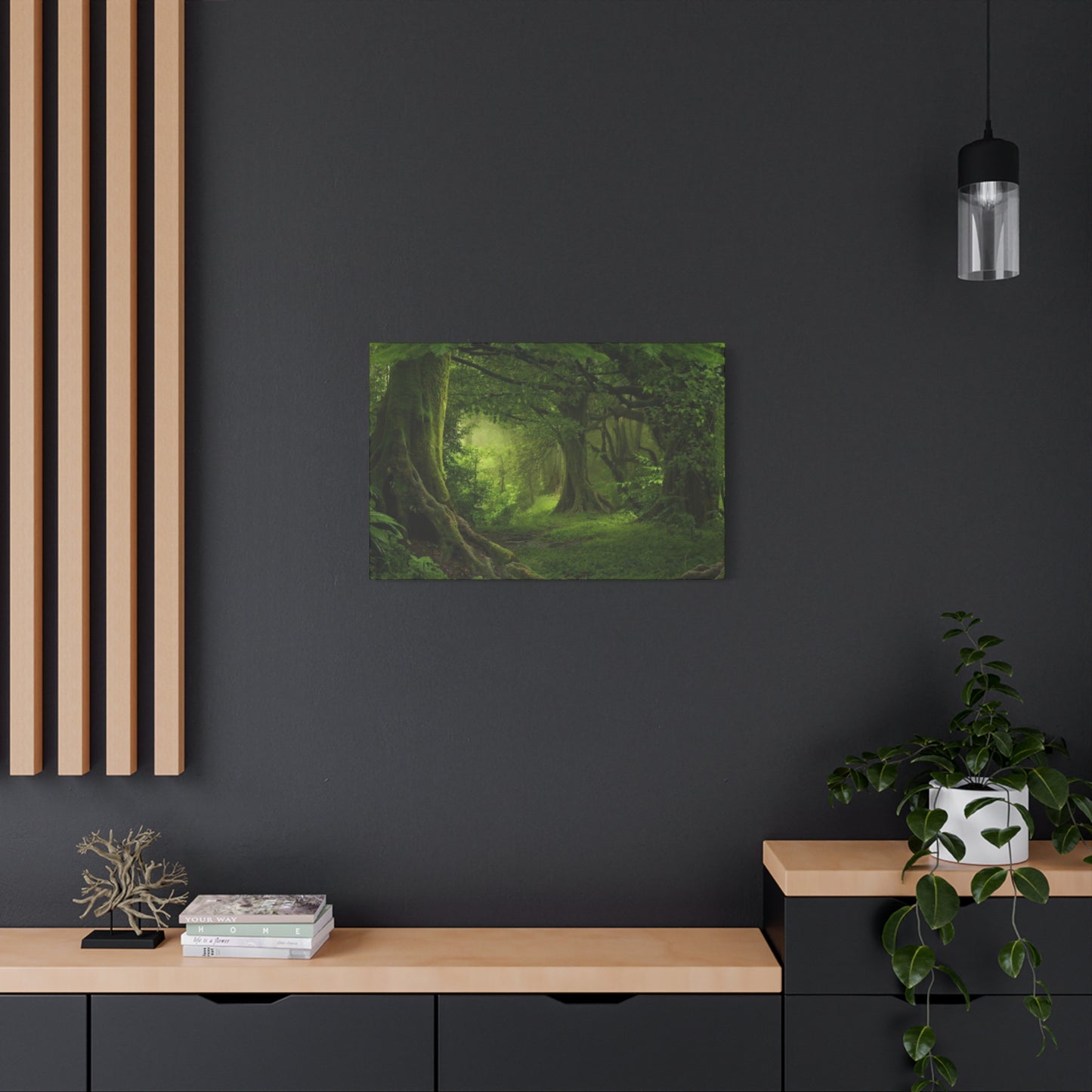Stunning Green Tropical Forest Wall Art: Nature's Modern Masterpiece
The allure of lush, verdant tropical forests has captivated humanity for centuries, and now you can bring this natural magnificence directly into your living environment through carefully selected green tropical forest wall art canvas prints. These breathtaking artistic creations offer an extraordinary opportunity to transform any room into a sanctuary of natural beauty, combining the serenity of pristine wilderness with contemporary artistic expression.
Green tropical forest wall art canvas prints represent more than mere decoration; they embody a connection to nature's most vibrant ecosystems. Each piece captures the essence of dense canopies, exotic vegetation, and the mysterious depths of tropical rainforests, creating an immersive visual experience that transcends traditional home décor boundaries. The rich emerald hues, intricate botanical details, and atmospheric depth of these artworks provide an instant escape to paradise, regardless of your geographical location.
The growing popularity of botanical-themed artwork reflects our collective desire to reconnect with nature in our increasingly urbanized world. These canvas prints serve as windows to untouched wilderness, offering daily reminders of the planet's extraordinary biodiversity and natural splendor. Whether displayed in living rooms, bedrooms, offices, or commercial establishments, green tropical forest wall art creates an atmosphere of tranquility and exotic sophistication.
Modern printing technologies have revolutionized the quality and accessibility of tropical forest artwork, enabling artists and photographers to capture the subtle nuances of light filtering through dense canopies, the texture of ancient tree bark, and the vibrant colors of tropical flora with unprecedented clarity. High-resolution canvas prints preserve every detail of these natural masterpieces, from the delicate patterns of fern fronds to the majestic silhouettes of towering trees.
The therapeutic benefits of surrounding yourself with nature-inspired artwork are well-documented by environmental psychologists and wellness experts. Green tropical forest wall art canvas prints can reduce stress levels, improve air quality perception, and enhance overall mental well-being by creating a biophilic connection within artificial environments. The calming influence of verdant imagery helps counteract the harsh edges of modern architecture and urban living.
Canvas prints offer distinct advantages over traditional paper prints, providing durability, longevity, and a professional gallery-quality appearance that enhances any decorative scheme. The texture of canvas adds depth and authenticity to tropical forest imagery, creating a more tactile and engaging visual experience. Unlike fragile paper prints that fade or tear easily, canvas prints maintain their vibrancy and structural integrity for decades with proper care.
Exploring the Rich Diversity of Tropical Forest Ecosystems Through Canvas Art
Tropical forests represent Earth's most biodiverse terrestrial ecosystems, housing an estimated 50% of all known species within just 7% of the planet's land surface. Green tropical forest wall art canvas prints celebrate this incredible diversity, showcasing various forest types from Amazon rainforests to Southeast Asian jungles, each with distinctive characteristics and visual appeal.
The Amazon rainforest, often called the "lungs of the Earth," provides inspiration for countless canvas prints featuring its iconic cecropia trees, massive mahogany specimens, and dense understory vegetation. Artists capture the Amazon's unique atmosphere, where humidity creates ethereal mists and filtered sunlight creates dramatic chiaroscuro effects through the multilayered canopy. These prints often emphasize the forest's vertical structure, from ground-level ferns and fallen logs to emergent giants reaching toward the sky.
Southeast Asian tropical forests offer different aesthetic qualities, with their distinctive dipterocarp trees, colorful epiphytes, and unique architectural forms of buttress roots and climbing vines. Canvas prints from this region frequently showcase the intricate patterns created by lianas weaving through trees, creating natural sculptures that inspire contemporary artistic interpretations. The region's monsoon influences create dynamic seasonal variations that artists capture in their forest imagery.
Central American cloud forests provide another rich source of inspiration, where persistent moisture creates mystical landscapes shrouded in mist. These high-altitude tropical forests feature unique vegetation adapted to constant humidity, including abundant mosses, bromeliads, and orchids that create tapestries of green in countless shades and textures. Canvas prints from cloud forests often emphasize the ethereal quality of light and atmosphere.
African tropical forests contribute their own distinctive visual elements, from the massive buttressed trees of the Congo Basin to the unique flora of Madagascar's isolated ecosystems. These forests showcase evolutionary adaptations found nowhere else on Earth, providing artists with extraordinary subjects for canvas prints that celebrate biological diversity and natural selection's creative power.
The layered structure of tropical forests creates natural compositions perfectly suited for wall art, with distinct canopy levels providing visual rhythm and depth. The emergent layer, dominated by the tallest trees, creates dramatic silhouettes against tropical skies. The main canopy forms a continuous green ceiling that filters and diffuses natural light, creating the forest's characteristic dim, green-tinted illumination that photographers and artists strive to capture.
Below the main canopy, the understory layer offers different artistic opportunities, with shade-tolerant plants creating intricate patterns of leaves and stems. Young trees stretching toward available light create vertical elements that add dynamism to compositions. The forest floor, though often dim, reveals fascinating details of decomposition, new growth, and the constant cycle of life and death that sustains tropical ecosystems.
Seasonal variations in tropical forests provide artists with diverse subjects throughout the year. While tropical forests lack the dramatic seasonal changes of temperate regions, subtle variations in rainfall, flowering cycles, and fruiting patterns create different moods and color palettes. Wet season imagery often emphasizes lush growth and abundant water features, while dry season prints might focus on the forest's resilience and adaptation strategies.
The acoustic environment of tropical forests adds another dimension to their appeal, though obviously not directly translatable to visual art. However, artists often attempt to convey the sense of abundant life through compositions that suggest movement, hidden wildlife, and the dynamic energy of thriving ecosystems. Prints might include subtle suggestions of bird flight paths, butterfly feeding areas, or mammal travel corridors through artistic arrangement of visual elements.
Styles in Tropical Forest Canvas Prints
The creation of compelling green tropical forest wall art canvas prints requires mastery of various artistic techniques and stylistic approaches, each offering unique ways to interpret and present the complexity of tropical ecosystems. Artists employ different methodologies to capture the essence of these magnificent environments, from photorealistic representations to abstract interpretations that distill the forest's emotional impact.
Photorealistic approaches dominate much of contemporary tropical forest art, utilizing advanced photographic techniques and digital post-processing to create images of stunning clarity and detail. High dynamic range photography allows artists to capture the extreme contrast between bright canopy openings and dark forest floors, preserving detail in both highlights and shadows that would be impossible with traditional photography. Multiple exposure techniques help overcome the technical challenges of forest photography, where light levels can vary by several stops within a single frame.
Macro photography techniques applied to tropical forest subjects reveal intricate worlds invisible to casual observation. Canvas prints featuring extreme close-ups of leaf surfaces, bark textures, or dewdrops on spider webs create abstract compositions that maintain connection to their natural origins while offering fresh perspectives on familiar subjects. These detailed studies often work effectively as series, allowing viewers to appreciate the incredible complexity present in even small sections of tropical forest.
Landscape photography approaches emphasize the grandeur and scale of tropical forests, often incorporating human elements or familiar objects to provide scale references that help viewers appreciate the immense size of ancient trees. Wide-angle lenses capture sweeping views of forest interiors, creating images that invite viewers to imagine walking through these cathedral-like environments. Telephoto lenses compress forest depth, creating layered compositions that emphasize the density and complexity of tropical vegetation.
Digital art and mixed media approaches offer artists additional creative freedom in interpreting tropical forest themes. Digital painting techniques allow for selective emphasis of certain elements while subduing others, creating compositions that guide viewer attention more deliberately than straight photography. Artists might enhance color saturation in key areas, add atmospheric effects, or combine multiple photographs into composite images that capture the essence of tropical forests without being constrained by single-moment documentation.
Watercolor and oil painting traditions continue to influence tropical forest art, even in digital formats. Artists often simulate traditional painting techniques through digital tools, creating canvas prints that maintain the spontaneity and expressive quality of hand-painted works while benefiting from digital reproduction's consistency and durability. These approaches often emphasize the emotional impact of tropical forests over literal documentation.
Abstract interpretations of tropical forest themes focus on color relationships, compositional rhythms, and emotional responses rather than detailed representation. These prints might use forest colors and forms as starting points for purely aesthetic explorations, creating artworks that evoke forest feelings without depicting specific botanical subjects. Abstract approaches often work well in contemporary settings where literal representation might feel out of place.
Vintage and historical styling creates tropical forest prints with nostalgic appeal, often mimicking the aesthetic of early botanical illustrations or expedition documentation. These pieces might incorporate aged color palettes, traditional composition techniques, or historical framing devices that reference humanity's long fascination with tropical exploration and discovery. Sepia tones, muted colors, and classical composition techniques create timeless appeal.
Contemporary minimalist approaches distill tropical forest imagery to essential elements, creating clean, sophisticated compositions that work well in modern architectural settings. These prints might focus on single specimen trees, simplified color palettes, or geometric arrangements of natural forms that complement contemporary furniture and architectural details while maintaining connection to natural themes.
Artistic lighting techniques play crucial roles in tropical forest canvas prints, as forest environments present unique illumination challenges and opportunities. Backlighting through leaves creates dramatic silhouettes and emphasizes the translucent qualities of tropical foliage. Side lighting reveals texture and three-dimensional form in tree trunks and forest floor elements. Soft, diffused lighting captures the mysterious atmosphere of deep forest interiors.
Color grading and post-processing techniques allow artists to enhance the natural drama of tropical forest environments, emphasizing the rich greens that characterize these ecosystems while maintaining natural authenticity. Selective color enhancement might boost the vibrancy of flowering plants or fruiting trees while keeping overall forest tones subdued and realistic. Contrast adjustments help separate different forest layers and create visual depth.
Green Tropical Forest Imagery
The profound psychological impact of green tropical forest wall art canvas prints stems from fundamental human responses to color and natural imagery that have evolved over millennia of evolutionary development. Understanding these psychological mechanisms helps explain why tropical forest art creates such powerful emotional and physiological responses in viewers, making it particularly effective for therapeutic and wellness applications.
Green, as the dominant color in tropical forest imagery, carries extensive psychological associations that influence human mood, behavior, and cognitive function. As the color most associated with nature, growth, and life, green triggers deeply rooted biological responses that signal safety, abundance, and health. In tropical forest contexts, the incredible variety of green hues creates rich visual experiences that stimulate multiple psychological pathways simultaneously.
The human visual system is evolutionarily optimized to detect subtle variations in green tones, a adaptation that helped our ancestors identify edible plants, fresh water sources, and safe shelter locations. This enhanced sensitivity to green variations means that tropical forest prints with their incredible range of green shades provide particularly rich visual stimulation that engages viewers on subconscious levels.
Research in environmental psychology demonstrates that exposure to green environments, even through imagery, reduces cortisol levels, lowers blood pressure, and decreases anxiety and depression symptoms. Green tropical forest wall art canvas prints provide accessible ways to gain these benefits in urban environments where direct nature contact may be limited. The immersive quality of large-scale canvas prints enhances these effects by creating more convincing natural environments.
Different shades of green evoke distinct psychological responses that artists can manipulate to create specific moods and atmospheres. Bright, yellow-tinged greens suggest new growth, vitality, and optimism, often appearing in tropical forest prints featuring young foliage or sunlit canopy areas. These energizing greens work well in active areas like home offices or exercise rooms where motivation and alertness are desired.
Deeper, blue-tinged greens convey stability, wisdom, and tranquility, often associated with mature forest areas or shadowed understory regions. These calming greens excel in relaxation areas like bedrooms or meditation rooms where stress reduction and peaceful atmospheres are priorities. The cooling psychological effect of blue-greens can also help balance warm color schemes or counteract harsh artificial lighting.
Mid-tone greens represent balance and harmony, providing neutral backgrounds that support rather than dominate decorative schemes. These versatile greens appear throughout tropical forest imagery and work well in multi-purpose areas where flexibility is important. They provide psychological stability without being passive or boring.
The complexity of green variations in tropical forest prints creates visual interest that holds attention without becoming overwhelming. Unlike solid color applications that might feel static or monotonous, the natural variations in forest imagery provide subtle stimulation that keeps viewers engaged while still promoting relaxation. This balance between interest and calm makes tropical forest art particularly suitable for extended viewing in residential and workplace settings.
Complementary colors appearing in tropical forest scenes enhance the psychological impact of green dominance. Small amounts of red from flowering plants or fruiting trees create dynamic tension that energizes compositions without disrupting overall harmony. Orange and yellow accents from flowers, fruits, or filtered sunlight add warmth and positivity. Purple and blue elements from shadows or flowering vines contribute depth and mystery.
The psychological concept of attention restoration theory explains why natural imagery, particularly complex scenes like tropical forests, helps recover from mental fatigue and directed attention demands. Tropical forest prints provide "soft fascination" that captures interest without requiring concentrated focus, allowing cognitive resources to recover from work or study demands. This makes forest art particularly valuable in work environments or study areas.
Biophilia, humanity's innate affinity for natural environments and living systems, creates positive emotional responses to tropical forest imagery that transcend cultural boundaries. Canvas prints featuring lush tropical vegetation tap into these fundamental human connections to nature, creating universal appeal that works across different demographic groups and cultural backgrounds.
The fractal patterns present in tropical forest imagery align with human visual processing preferences, creating compositions that feel naturally harmonious and pleasant to observe. Tree branching patterns, leaf arrangements, and root systems follow mathematical relationships that human brains find inherently satisfying, contributing to the widespread appeal of forest-themed artwork.
Seasonal Affective Disorder and related conditions linked to insufficient natural light exposure can be partially addressed through tropical forest wall art that creates associations with bright, verdant environments. While not replacing light therapy, forest imagery can provide psychological support by maintaining connections to vital natural environments during periods of limited outdoor access.
The psychological benefits of tropical forest imagery extend beyond individual viewers to influence group dynamics and social interactions. Shared appreciation for natural beauty creates common ground that facilitates positive social connections, making forest art valuable in communal areas where social cohesion is important.
Technical Aspects of Canvas Print Production and Quality
The transformation of tropical forest imagery into high-quality wall art canvas prints involves sophisticated technical processes that significantly impact the final artwork's appearance, durability, and value. Understanding these technical aspects helps consumers make informed decisions when selecting tropical forest prints and ensures optimal display results that preserve the artist's original vision.
Canvas material selection forms the foundation of quality print production, with different fabric types offering distinct advantages for tropical forest imagery. Pure cotton canvas provides excellent color absorption and natural texture that complements organic forest themes. The slightly irregular weave of cotton canvas adds subtle texture variations that enhance the natural feel of tropical forest prints without competing with fine image details.
Cotton-polyester blend canvases offer increased durability and dimensional stability, particularly important for large-format tropical forest prints that might experience temperature and humidity fluctuations. The synthetic fibers resist stretching and maintain tension better than pure cotton, reducing the risk of sagging or warping over time. These blends often accept inks more uniformly, resulting in consistent color reproduction across the entire print surface.
Canvas weight, measured in ounces per square yard, affects both appearance and longevity of tropical forest prints. Lighter weight canvases (around 10-12 oz) provide smooth surfaces ideal for fine detail reproduction but may lack the substantial feel expected in premium art prints. Medium weight canvases (14-16 oz) balance detail reproduction with substantial texture and durability. Heavy weight canvases (18+ oz) create museum-quality presentations with pronounced texture but may obscure fine details in complex tropical forest imagery.
Printing technology choices dramatically influence the final appearance of tropical forest canvas prints. Giclée printing, utilizing high-resolution inkjet technology with archival pigment inks, represents the current standard for fine art reproduction. This process can reproduce the subtle color gradations and fine details essential for convincing tropical forest imagery, with color gamuts wide enough to capture the full spectrum of forest greens and complementary colors.
Inkjet printing systems designed specifically for canvas substrates use specialized ink formulations that penetrate canvas fibers while maintaining surface detail and color vibrancy. UV-resistant pigment inks prevent color fading from exposure to natural light, particularly important for tropical forest prints that often feature predominant green tones that can shift over time with inferior inks.
Color management throughout the printing process ensures that tropical forest prints accurately reproduce the artist's original color intentions. Professional color calibration systems maintain consistency between digital source files and final canvas prints, accounting for the specific characteristics of canvas substrates and ink systems. This technical precision is particularly crucial for forest imagery where subtle color variations carry significant aesthetic impact.
Resolution requirements for tropical forest canvas prints depend on viewing distance and print size. Large format prints intended for wall display typically require lower resolution than smaller prints viewed at close range. However, tropical forest imagery often benefits from higher resolution capture and printing to preserve the intricate details of foliage, bark textures, and forest floor elements that contribute to the overall impact.
Stretching and mounting processes significantly affect the final presentation of tropical forest canvas prints. Gallery wrap mounting, where the image extends around the canvas edges, creates seamless presentations ideal for contemporary display without frames. Museum wrap mounting maintains image boundaries on the front surface while using solid colors or image extensions on the sides.
Canvas preparation prior to printing involves priming and coating processes that optimize ink adhesion and color reproduction. High-quality primers create uniform surfaces that prevent ink bleeding while maintaining canvas texture. Specialized coatings can enhance color vibrancy, improve fade resistance, or add protective properties that extend print lifespan.
Quality control processes throughout production ensure consistent results across multiple prints of the same tropical forest image. Color matching systems verify that each print meets established standards, while physical inspection processes check for defects, proper stretching, and mounting quality. These controls are particularly important for tropical forest prints where color accuracy and detail preservation are critical.
Post-printing treatments can enhance the longevity and appearance of tropical forest canvas prints. UV protective coatings add an additional layer of fade resistance without significantly altering color appearance. Texture enhancement treatments can emphasize canvas weave patterns that complement natural forest themes. Anti-reflective treatments reduce glare that might interfere with forest imagery viewing.
Storage and handling procedures protect canvas prints during shipping and before installation. Proper packaging prevents moisture damage, physical scratches, and pressure marks that could affect print appearance. Climate-controlled storage maintains optimal conditions for canvas and ink stability.
Environmental testing ensures that tropical forest canvas prints maintain quality under various display conditions. Accelerated aging tests predict long-term color stability and material performance. Humidity and temperature cycling tests verify dimensional stability and adhesion properties. Light fastness testing confirms fade resistance under various lighting conditions.
Selecting the Perfect Size and Placement for Maximum Impact
The strategic selection of appropriate sizes and optimal placement locations for green tropical forest wall art canvas prints significantly influences their visual impact and integration within living or working environments. Understanding principles of proportion, viewing distance, and spatial relationships enables homeowners and decorators to maximize the aesthetic and psychological benefits of tropical forest imagery.
Large format tropical forest prints, typically ranging from 36 inches to 60 inches or larger in width, create immersive experiences that transport viewers into forest environments. These substantial pieces work exceptionally well as focal points in living rooms, master bedrooms, or office reception areas where they can command attention and establish the overall aesthetic tone. The grand scale allows for appreciation of fine details while maintaining visual impact from across larger rooms.
When considering large format prints, ceiling height becomes a crucial factor in maintaining proper proportions. Rooms with standard 8-foot ceilings can accommodate horizontal formats up to about 48 inches in height, while vertical orientations might be limited to maintain appropriate spacing from ceiling and furniture. Higher ceilings provide opportunities for even larger prints or multiple panel installations that create dramatic tropical forest environments.
Medium-sized tropical forest prints, generally 24 to 36 inches in their longest dimension, offer versatility that works well in various settings without overwhelming architectural features or existing décor. These proportions suit dining rooms, guest bedrooms, home offices, or commercial spaces where sophisticated natural imagery is desired without dominating the environment. Medium prints also work effectively in groupings that create gallery wall arrangements.
Small format tropical forest prints, under 24 inches, excel in intimate settings or as part of larger groupings. These sizes work well in bathrooms, hallways, breakfast nooks, or personal office areas where close viewing allows appreciation of fine details. Small prints can be grouped in series to create narrative progressions through different forest environments or seasonal variations.
Viewing distance calculations help determine optimal print sizes for specific locations. A general guideline suggests that the print width should be approximately one-quarter to one-third of the viewing distance for comfortable appreciation without requiring eye movement across the entire image. For seating areas where viewers will be 8-10 feet from the wall, prints between 24-36 inches wide provide optimal visual engagement.
Height placement significantly affects the viewing experience and integration with room architecture. The center of artwork should generally align with eye level, typically 57-60 inches from the floor for average adult height. However, this can be adjusted based on primary viewing positions – artwork above seating might be placed slightly higher to accommodate the natural eye level when seated.
Horizontal versus vertical orientation choices depend on both wall proportions and the specific tropical forest imagery being displayed. Horizontal formats work well above sofas, beds, or long furniture pieces, creating visual harmony through repeated horizontal lines. These orientations suit landscape-style forest views that emphasize the breadth and depth of tropical environments.
Vertical orientations create dramatic impact in narrow wall areas, stairwells, or beside tall furniture pieces. They work particularly well for tropical forest images that emphasize the towering height of rainforest canopies or the vertical structure of forest layers. Vertical formats can make rooms appear taller and add dynamic energy to horizontal-dominated room layouts.
Multi-panel installations, such as diptychs or triptychs, allow for creative interpretations of tropical forest environments while accommodating various wall proportions and architectural features. These arrangements can tell visual stories that progress through different forest areas or times of day, creating engaging experiences that reward extended viewing. Panel spacing should maintain visual connection while allowing each element to function independently.
Corner placements for tropical forest prints can transform underutilized areas into focal points while creating wraparound effects that enhance the immersive quality of forest imagery. Corner installations work particularly well with vertical formats that draw the eye upward and create illusions of extended room height. Proper lighting becomes even more critical in corner placements to prevent shadows that might diminish print visibility.
Relationship to natural light sources affects both color perception and long-term print preservation. Tropical forest prints benefit from indirect natural light that enhances their green color palette without creating glare or accelerating fading. Placement opposite windows can provide ideal viewing conditions while minimizing direct light exposure. UV-filtering window treatments offer additional protection while maintaining natural illumination.
Artificial lighting considerations include both general room illumination and specific accent lighting for artwork appreciation. LED track lighting or picture lights can enhance tropical forest prints while providing UV-free illumination that won't damage canvas or inks. Warm light temperatures (2700K-3000K) complement the natural warmth of forest imagery while cooler temperatures (4000K+) can enhance the fresh, vital feeling of green vegetation.
Furniture relationships affect both placement options and visual integration. Tropical forest prints work well above seating arrangements where they create contemplative focal points for relaxation. Above dining tables, forest imagery can create calming atmospheres that enhance meal experiences. In bedrooms, forest prints positioned for easy viewing from bed provide peaceful images that support relaxation and sleep quality.
Architectural feature integration, such as placement relative to fireplaces, built-in shelving, or structural elements, requires careful consideration of proportions and visual balance. Tropical forest prints can soften hard architectural lines while maintaining respect for existing design elements. Symmetrical placement around architectural features creates formal balance while asymmetrical arrangements add dynamic energy.
Complementary Design Elements and Color Coordination
The successful integration of green tropical forest wall art canvas prints into existing décor schemes requires thoughtful consideration of complementary design elements and strategic color coordination that enhances rather than conflicts with the natural imagery. Understanding how tropical forest artwork interacts with surrounding elements enables homeowners to create cohesive, visually appealing environments that maximize the aesthetic impact of their chosen pieces.
Neutral color palettes provide excellent foundations for tropical forest artwork, allowing the rich greens and natural tones of forest imagery to serve as primary color sources without competing with existing décor elements. Warm neutrals like cream, beige, and soft gray create welcoming backgrounds that complement the organic feel of tropical forests while maintaining sophisticated appearances suitable for contemporary homes.
Cool neutrals, including soft whites, light grays, and pale blues, offer clean, modern foundations that make tropical forest greens appear more vibrant and fresh. These color schemes work particularly well in minimalist or contemporary settings where the natural complexity of forest imagery provides welcome organic contrast to clean architectural lines and simplified décor approaches.
Earth tone color schemes naturally harmonize with tropical forest artwork, creating cohesive natural environments that feel organic and unified. Browns, tans, and warm grays echo the forest floor and tree bark elements often present in tropical forest prints, while rust and terracotta tones can complement flowering elements or warm lighting effects captured in forest photography.
Monochromatic green color schemes, utilizing various shades and tones of green throughout room décor, create immersive natural environments that amplify the impact of tropical forest artwork. However, these schemes require careful balance to avoid becoming overwhelming or monotonous. Varying textures, patterns, and green intensities creates visual interest while maintaining color harmony.
Complementary color accents, particularly those featuring oranges, reds, and warm yellows, can enhance tropical forest prints by creating dynamic color relationships that increase visual energy and interest. These warm accents might appear in throw pillows, decorative accessories, or flowers that echo the flowering elements sometimes present in tropical forest imagery.
Furniture selection significantly influences how tropical forest artwork integrates into room designs. Natural wood furniture, particularly in warm tones like teak, mahogany, or cherry, creates organic connections with forest imagery while providing complementary textures that enhance the natural theme. Reclaimed wood pieces add authenticity and environmental consciousness that aligns with forest conservation themes.
Rattan and wicker furniture elements reinforce tropical themes while providing textural variety that complements the organic complexity of forest imagery. These natural materials create casual, relaxed atmospheres that work well with the stress-reducing benefits of tropical forest art. Bamboo furniture offers sustainable options that support environmental themes while providing clean, contemporary lines.
Upholstered furniture in natural fabrics like linen, cotton, or hemp creates textural connections to organic themes while providing comfortable seating for artwork appreciation. Fabric colors should either harmonize with forest greens or provide subtle contrasts that don't compete with the artwork's natural beauty. Patterns should be simple enough to avoid visual conflict with complex forest imagery.
Textile selections throughout the room, including curtains, throw pillows, and area rugs, offer opportunities to reinforce or complement tropical forest themes. Natural fiber textiles provide textural authenticity while synthetic options can offer practical benefits like stain resistance and easy care. Patterns might echo botanical themes without exactly replicating forest imagery, creating layered natural references.
Lighting design plays crucial roles in artwork presentation and overall room atmosphere. Natural light should be managed to enhance forest artwork without causing damage, using UV-filtering window treatments when necessary. Artificial lighting can create mood variations that support different activities while maintaining appropriate illumination for artwork appreciation.
Plant selections for rooms featuring tropical forest artwork can create living extensions of the artistic themes while improving air quality and adding authentic natural elements. Large floor plants like fiddle leaf figs, monstera, or bird of paradise create architectural elements that complement forest imagery scale. Smaller plants can be grouped to create mini tropical environments that support artwork themes.
However, live plant selections should be made carefully to avoid overwhelming the artwork or creating visual competition. Plants with similar green tones to those in the artwork should be positioned to create harmony rather than conflict. Flowering plants can provide seasonal color accents that complement artwork elements without permanent color commitment.
Decorative accessory choices offer opportunities for subtle theme reinforcement without creating overly literal tropical interpretations. Natural materials like stone, wood, or ceramic can provide textural variety while maintaining organic themes. Metallic accents in warm tones like bronze or copper can add sophistication while echoing natural elements like sunlight filtering through forest canopies.
Window treatment selection affects both natural light management and overall room aesthetics. Natural fiber curtains or blinds in neutral tones provide practical light control while maintaining organic theme consistency. Avoid overly tropical patterns that might compete with forest artwork – instead, choose simple textures that complement without mimicking.
Flooring considerations can significantly impact how tropical forest artwork integrates into room designs. Hardwood floors provide natural foundations that connect with forest themes while offering timeless appeal and practical benefits. Bamboo flooring offers sustainable options that support environmental consciousness while providing clean, contemporary appearances.
Area rug selection can define seating areas while providing additional textural and color elements that support forest artwork themes. Natural fiber rugs in neutral tones create organic foundations while geometric patterns can add contemporary sophistication that balances the organic complexity of forest imagery.
Maintaining Canvas Prints
Proper care and maintenance of green tropical forest wall art canvas prints ensures their longevity, color vibrancy, and continued aesthetic appeal throughout their display lifetime. Understanding appropriate cleaning techniques, environmental considerations, and protective measures helps preserve these artistic investments while maintaining their ability to provide the psychological and aesthetic benefits that make tropical forest artwork so valuable.
Environmental factors significantly influence canvas print longevity and appearance. Temperature stability prevents expansion and contraction cycles that can stress canvas materials and cause premature aging. Ideal display temperatures range between 65-75°F (18-24°C) with minimal fluctuation throughout daily and seasonal cycles. Extreme temperatures should be avoided, particularly heat sources like radiators, heating vents, or areas receiving direct sunlight that can cause rapid temperature changes.
Humidity control protects both canvas materials and ink systems from moisture-related damage. Relative humidity levels between 45-55% provide optimal conditions for most canvas prints. Excessive humidity can promote mold growth, cause canvas stretching, or affect ink adhesion, while insufficient humidity may cause canvas brittleness and cracking. Humidifiers or dehumidifiers can help maintain appropriate levels in challenging climates.
Light exposure management prevents color fading while allowing for artwork appreciation and display. UV radiation poses the greatest threat to canvas print longevity, making UV-filtering glass or protective coatings valuable investments for premium pieces. Even LED lighting, while safer than incandescent bulbs, should be positioned to minimize direct illumination that could accelerate fading over time.
Indirect lighting strategies provide adequate illumination for artwork appreciation while minimizing damage risks. Track lighting positioned to graze artwork surfaces reduces direct exposure while highlighting texture and detail. Ambient room lighting often provides sufficient illumination for casual viewing while preserving prints for extended lifespans.
Dust accumulation represents the most common maintenance challenge for canvas prints, requiring regular attention to preserve appearance and prevent particle embedding that could cause permanent damage. Soft-bristled brushes, microfiber cloths, or vacuum brushes on low settings can remove surface dust without damaging canvas texture or printed surfaces.
Cleaning frequency depends on environmental conditions, with homes in dusty areas or those with pets requiring more frequent attention. Monthly light dusting prevents significant accumulation while quarterly more thorough cleaning can address deeper particle settling. Professional cleaning may be warranted for valuable pieces or those in challenging environments.
Handling procedures during cleaning or repositioning require careful attention to prevent damage from oils, pressure, or improper support. Clean, dry hands or cotton gloves prevent oil transfer that can attract dirt or cause staining. Support large prints from multiple points to prevent stress concentration that could cause tearing or mounting failure.
Stain removal techniques vary depending on stain type and canvas preparation. Water-based stains may respond to gentle blotting with clean, damp cloths, working from outside edges toward centers to prevent spreading. Oil-based stains typically require professional conservation treatment to avoid spreading or permanent damage to canvas or inks.
Professional conservation services provide expertise for valuable or damaged canvas prints that require specialized treatment beyond routine maintenance capabilities. These services can address more serious problems like tear repair, color restoration, or environmental damage that threatens print integrity or appearance.
Protective measures can prevent many common damage sources that threaten canvas prints. Frame backing boards or dust covers protect against environmental contaminants while allowing air circulation that prevents moisture accumulation. Corner protectors can prevent impact damage during handling or from furniture contact.
Storage procedures for prints not currently displayed require climate-controlled environments and appropriate packaging that prevents physical damage, moisture accumulation, or pest intrusion. Flat storage is preferred when possible, with acid-free interleaving materials preventing surface contact that could cause sticking or transfer.
Rotation strategies for multiple prints can minimize cumulative light exposure while providing variety in displayed artwork. Prints can be exchanged seasonally or according to room use patterns, allowing each piece recovery time in controlled storage while maintaining fresh visual experiences in display areas.
Insurance considerations may warrant documentation of canvas prints through photography and purchase records that establish value for replacement or repair coverage. Professional appraisals might be appropriate for valuable or limited edition pieces that represent significant investments.
Monitoring techniques help identify potential problems before they become serious threats to print integrity. Regular inspection for signs of fading, staining, pest activity, or physical damage enables prompt intervention that can prevent minor issues from becoming major conservation challenges.
Mounting system maintenance ensures continued secure display while preventing damage from falling or improper hanging. Regular inspection of hanging hardware, wall anchors, and mounting points prevents failures that could damage both artwork and surrounding areas. Weight distribution systems may require periodic adjustment to maintain proper tension and support.
Wellness Benefits of Forest-Themed Artwork
The incorporation of green tropical forest wall art canvas prints into living and working environments provides documented health and wellness benefits that extend far beyond aesthetic enhancement, contributing to physical health improvements, mental wellness support, and overall quality of life enhancement through mechanisms that connect humans with beneficial natural environments.
Stress reduction represents one of the most significant and measurable benefits of tropical forest artwork exposure. Research in environmental psychology consistently demonstrates that viewing natural imagery, particularly green forest environments, triggers parasympathetic nervous system responses that counteract stress-induced physiological changes. Heart rate variability improves, cortisol levels decrease, and blood pressure measurements show favorable changes even from brief exposure to forest imagery.
The Japanese concept of "shinrin-yoku" or forest bathing has gained international recognition for its health benefits, and while tropical forest canvas prints cannot fully replicate forest immersion experiences, they can provide accessible alternatives that deliver many similar benefits. Regular viewing of forest imagery helps maintain connections to natural environments that support mental health and psychological well-being.
Attention restoration theory explains how natural imagery helps recover cognitive resources depleted by directed attention demands common in modern work and study environments. Tropical forest prints provide "soft fascination" that captures interest without requiring focused concentration, allowing mental restoration that improves subsequent cognitive performance and reduces mental fatigue.
Sleep quality improvements often result from bedroom placement of calming tropical forest artwork that creates peaceful, natural atmospheres conducive to relaxation and rest. The predominant green colors in forest imagery promote tranquility while the organic complexity provides visual interest that supports meditation and stress release before sleep. Many individuals report improved sleep onset and more restful sleep with nature-themed bedroom décor.
Air quality perception improves in rooms featuring natural imagery, even without actual air quality changes. This psychological phenomenon demonstrates how environmental cues influence health perceptions and actual physiological responses. While canvas prints don't improve actual air quality, they can enhance the sense of freshness and vitality associated with natural environments.
Conclusion
Stunning green tropical forest wall art represents the perfect marriage between modern design and the timeless beauty of nature. These captivating pieces bring the lush vibrancy of tropical landscapes right into your living space, transforming ordinary walls into breathtaking focal points. By incorporating such artwork into your home or office, you not only celebrate the rich textures and vivid hues of the forest but also invite a sense of calm, vitality, and renewal into your everyday environment.
Tropical forest art captures the intricate details of nature’s wonders — from the sweeping canopies and dense foliage to the interplay of light and shadow on leaves. This immersive quality allows viewers to feel connected to the outdoors, even when inside. The lush greens and natural patterns work harmoniously to create a soothing atmosphere, which can reduce stress and enhance creativity. Whether displayed in a modern minimalist room or a more eclectic space, tropical forest wall art offers a versatile and striking design element.
In addition to its aesthetic appeal, tropical forest art aligns with a growing desire to bring natural elements indoors, reflecting biophilic design principles. This approach fosters well-being by reconnecting people with nature, which is especially important in today’s fast-paced, urbanized world. The green tones found in tropical forest prints are not only visually pleasing but are also associated with growth, balance, and harmony—qualities that can positively influence the mood and energy of any space.
Moreover, stunning tropical forest wall art is available in a wide range of styles and mediums, from detailed photographic prints to abstract interpretations and mixed-media creations. This variety ensures that every individual can find the perfect piece that resonates with their personal taste and complements their decor. Whether you choose a large-scale mural or a series of smaller prints, the impact remains powerful, turning your walls into a celebration of nature’s grandeur.
In summary, stunning green tropical forest wall art is more than just decoration; it’s an experience. It brings the beauty, energy, and tranquility of the natural world indoors, elevating your space with both modern artistry and timeless natural charm. Embrace this masterpiece of nature to refresh your environment and inspire your everyday life.









